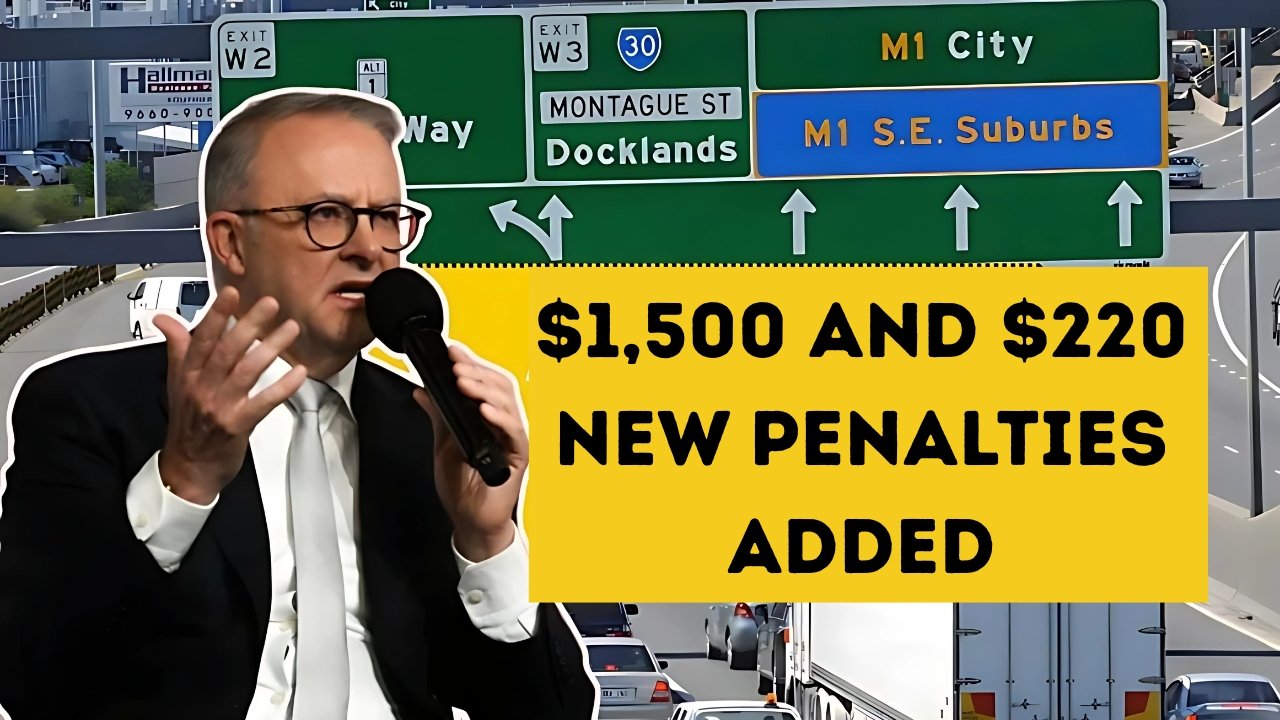Australia is once again tightening the screws on road safety. Starting October 2025, drivers across the country will face two brand-new penalties—a hefty $1,500 fine for major violations and a smaller but still significant $220 penalty for lesser offences. At first glance, these numbers may sound like just another government revenue tactic, but dig a little deeper, and you’ll see it’s really about pushing safer behavior behind the wheel.
To be fair, Australia already has some of the strictest road rules in the world. But despite that, accidents, reckless driving, and careless mistakes continue to happen every day. So the government believes that by setting these new penalty amounts, it’ll discourage drivers from taking risks, even small ones, and create a stronger culture of road responsibility.
What Are the New Penalties Exactly?
Let’s break it down in a simple way. From October 2025:
| Penalty Amount | Reason / Offence Type | Notes |
|---|---|---|
| $1,500 Fine | For severe road safety breaches such as dangerous driving, ignoring red lights in critical zones, or high-risk mobile phone use while driving. | Considered a major safety threat. May also lead to demerit points and possible license suspension. |
| $220 Fine | For minor yet impactful offences like failing to wear a seatbelt properly, not giving way to pedestrians, or low-level speeding (up to 10 km/h over). | Designed to target careless mistakes that still endanger lives. |
Honestly, it’s clear that the $1,500 fine is meant to sting. It’s not something most people can brush off easily, and that’s the point—it’s supposed to hurt financially so that you’ll think twice before repeating that behavior.
The $220 fine, on the other hand, is more like a nudge. It’s enough to make you annoyed at yourself for being careless but not as devastating as the bigger penalty. Together, these two cover the spectrum of road behaviours—from the extremely reckless to the absent-minded slip-ups.
Why This Change, and Why Now?
Good question. The government hasn’t pulled this number out of thin air. Over the past few years, accident data has shown that a large percentage of road crashes are linked to two categories:
- High-risk behaviors (speeding excessively, running red lights, texting at high speeds).
- Everyday mistakes (seatbelt misuse, low-speed crashes, ignoring simple rules).
To reduce both, policymakers decided they needed a double-edged approach—hammer the dangerous actions with a giant penalty, while still keeping pressure on everyday carelessness with a smaller fine.
Also, road safety campaigns alone can only do so much. Let’s be honest: people often pay attention only when their wallet is at risk.
What Does This Mean for Drivers?
Well, if you’re a cautious driver already, not much will change. You’ll continue to drive responsibly and, ideally, you’ll never have to think about these fines at all. But if you’re someone who tends to get “comfortable” bending the rules—like glancing at your phone at the lights or rolling through a stop sign—you might want to re-think those habits before October arrives.
Even the smaller $220 penalty will quickly add up if repeated. And let’s not even get into the $1,500 fine—that’s basically a month’s rent, or a long holiday gone in seconds.
On the flip side, some critics argue that Australia’s fines are already among the highest in the world. They worry that piling on bigger penalties could hit low-income drivers harder than habitual offenders. That’s a fair concern. But the government insists that safety is the priority, and the new amounts are carefully set to target behavior, not wallets.
Community Response
Reactions are mixed. Road safety advocates are cheering, saying it’s about time Australia doubled down on careless and reckless driving. They argue that too many lives are lost each year to avoidable accidents, and if tougher fines make even a small difference, it’s worth it.
Meanwhile, everyday drivers feel nervous. Sure, nobody wants unsafe roads, but some are questioning whether fines this high are actually practical—or just a way to boost revenue.
Either way, October 2025 is coming, and the rules won’t change just because people are uncomfortable. The safest bet is to adapt early and treat these penalties as a strong reminder that every small choice on the road matters.
At the end of the day, the message is simple: drive safely or risk paying a steep price. The new $1,500 fine is clearly a hammer for serious violations, while the $220 fine acts as a corrective nudge for smaller infractions. Whether you agree with the amounts or not, one thing is undeniable—Australia wants safer roads, and this is their latest strategy to make it happen.
So, the real question is—do you want to keep your hard-earned cash in your wallet, or hand it over for a split-second mistake? The choice, as always, rests with the driver.
FAQs
1. When will the new fines take effect?
They officially begin in October 2025 across Australia.
2. What is the highest penalty amount under the new rule?
The highest new fine is $1,500 for serious offences.
3. What kinds of mistakes could result in a $220 fine?
Minor offences such as seatbelt misuse, failing to give way, or low-level speeding.
4. Will demerit points also apply with these fines?
Yes, depending on the offence, fines can also come with demerit points and even license suspension.
5. Are these fines the same in every state?
Yes, the October 2025 update is meant to apply nationally, though some states may still add their own stricter measures.
